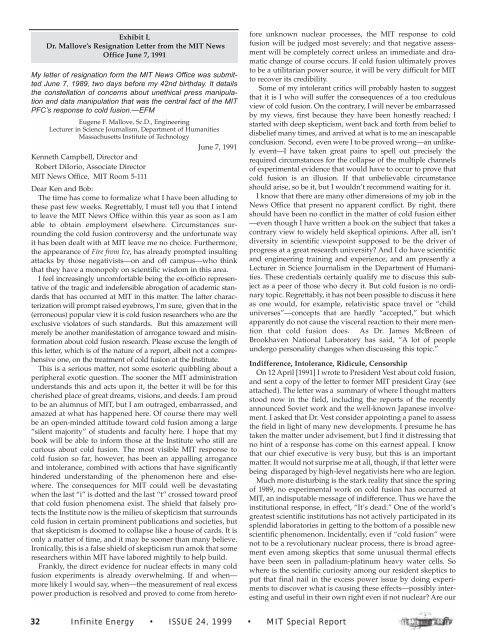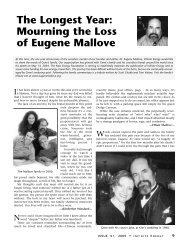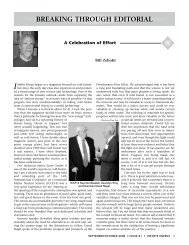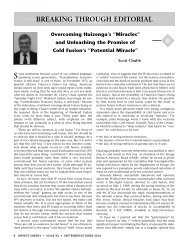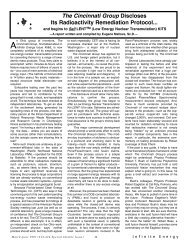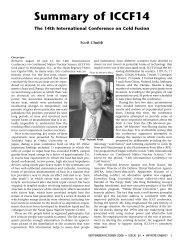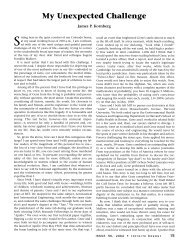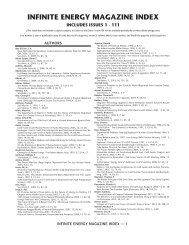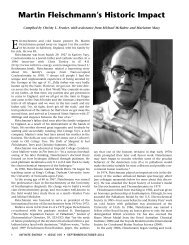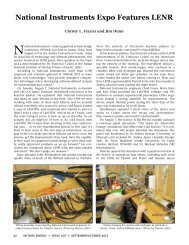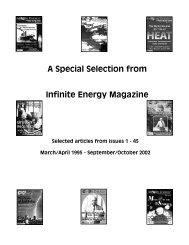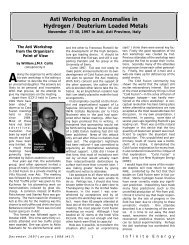MIT and Cold Fusion: A Special Report - Infinite Energy Magazine
MIT and Cold Fusion: A Special Report - Infinite Energy Magazine
MIT and Cold Fusion: A Special Report - Infinite Energy Magazine
You also want an ePaper? Increase the reach of your titles
YUMPU automatically turns print PDFs into web optimized ePapers that Google loves.
Exhibit L<br />
Dr. Mallove’s Resignation Letter from the <strong>MIT</strong> News<br />
Office June 7, 1991<br />
My letter of resignation form the <strong>MIT</strong> News Office was submitted<br />
June 7, 1989, two days before my 42nd birthday. It details<br />
the constellation of concerns about unethical press manipulation<br />
<strong>and</strong> data manipulation that was the central fact of the <strong>MIT</strong><br />
PFC’s response to cold fusion.—EFM<br />
Eugene F. Mallove, Sc.D., Engineering<br />
Lecturer in Science Journalism, Department of Humanities<br />
Massachusetts Institute of Technology<br />
June 7, 1991<br />
Kenneth Campbell, Director <strong>and</strong><br />
Robert DiIorio, Associate Director<br />
<strong>MIT</strong> News Office, <strong>MIT</strong> Room 5-111<br />
Dear Ken <strong>and</strong> Bob:<br />
The time has come to formalize what I have been alluding to<br />
these past few weeks. Regrettably, I must tell you that I intend<br />
to leave the <strong>MIT</strong> News Office within this year as soon as I am<br />
able to obtain employment elsewhere. Circumstances surrounding<br />
the cold fusion controversy <strong>and</strong> the unfortunate way<br />
it has been dealt with at <strong>MIT</strong> leave me no choice. Furthermore,<br />
the appearance of Fire from Ice, has already prompted insulting<br />
attacks by those negativists—on <strong>and</strong> off campus—who think<br />
that they have a monopoly on scientific wisdom in this area.<br />
I feel increasingly uncomfortable being the ex-officio representative<br />
of the tragic <strong>and</strong> indefensible abrogation of academic st<strong>and</strong>ards<br />
that has occurred at <strong>MIT</strong> in this matter. The latter characterization<br />
will prompt raised eyebrows, I’m sure, given that in the<br />
(erroneous) popular view it is cold fusion researchers who are the<br />
exclusive violators of such st<strong>and</strong>ards. But this amazement will<br />
merely be another manifestation of arrogance toward <strong>and</strong> misinformation<br />
about cold fusion research. Please excuse the length of<br />
this letter, which is of the nature of a report, albeit not a comprehensive<br />
one, on the treatment of cold fusion at the Institute.<br />
This is a serious matter, not some esoteric quibbling about a<br />
peripheral exotic question. The sooner the <strong>MIT</strong> administration<br />
underst<strong>and</strong>s this <strong>and</strong> acts upon it, the better it will be for this<br />
cherished place of great dreams, visions, <strong>and</strong> deeds. I am proud<br />
to be an alumnus of <strong>MIT</strong>, but I am outraged, embarrassed, <strong>and</strong><br />
amazed at what has happened here. Of course there may well<br />
be an open-minded attitude toward cold fusion among a large<br />
“silent majority” of students <strong>and</strong> faculty here. I hope that my<br />
book will be able to inform those at the Institute who still are<br />
curious about cold fusion. The most visible <strong>MIT</strong> response to<br />
cold fusion so far, however, has been an appalling arrogance<br />
<strong>and</strong> intolerance, combined with actions that have significantly<br />
hindered underst<strong>and</strong>ing of the phenomenon here <strong>and</strong> elsewhere.<br />
The consequences for <strong>MIT</strong> could well be devastating<br />
when the last “i” is dotted <strong>and</strong> the last “t” crossed toward proof<br />
that cold fusion phenomena exist. The shield that falsely protects<br />
the Institute now is the milieu of skepticism that surrounds<br />
cold fusion in certain prominent publications <strong>and</strong> societies, but<br />
that skepticism is doomed to collapse like a house of cards. It is<br />
only a matter of time, <strong>and</strong> it may be sooner than many believe.<br />
Ironically, this is a false shield of skepticism run amok that some<br />
researchers within <strong>MIT</strong> have labored mightily to help build.<br />
Frankly, the direct evidence for nuclear effects in many cold<br />
fusion experiments is already overwhelming. If <strong>and</strong> when—<br />
more likely I would say, when—the measurement of real excess<br />
power production is resolved <strong>and</strong> proved to come from heretofore<br />
unknown nuclear processes, the <strong>MIT</strong> response to cold<br />
fusion will be judged most severely; <strong>and</strong> that negative assessment<br />
will be completely correct unless an immediate <strong>and</strong> dramatic<br />
change of course occurs. If cold fusion ultimately proves<br />
to be a utilitarian power source, it will be very difficult for <strong>MIT</strong><br />
to recover its credibility.<br />
Some of my intolerant critics will probably hasten to suggest<br />
that it is I who will suffer the consequences of a too credulous<br />
view of cold fusion. On the contrary, I will never be embarrassed<br />
by my views, first because they have been honestly reached; I<br />
started with deep skepticism, went back <strong>and</strong> forth from belief to<br />
disbelief many times, <strong>and</strong> arrived at what is to me an inescapable<br />
conclusion. Second, even were I to be proved wrong—an unlikely<br />
event—I have taken great pains to spell out precisely the<br />
required circumstances for the collapse of the multiple channels<br />
of experimental evidence that would have to occur to prove that<br />
cold fusion is an illusion. If that unbelievable circumstance<br />
should arise, so be it, but I wouldn’t recommend waiting for it.<br />
I know that there are many other dimensions of my job in the<br />
News Office that present no apparent conflict. By right, there<br />
should have been no conflict in the matter of cold fusion either<br />
—even though I have written a book on the subject that takes a<br />
contrary view to widely held skeptical opinions. After all, isn’t<br />
diversity in scientific viewpoint supposed to be the driver of<br />
progress at a great research university? And I do have scientific<br />
<strong>and</strong> engineering training <strong>and</strong> experience, <strong>and</strong> am presently a<br />
Lecturer in Science Journalism in the Department of Humanities.<br />
These credentials certainly qualify me to discuss this subject<br />
as a peer of those who decry it. But cold fusion is no ordinary<br />
topic. Regrettably, it has not been possible to discuss it here<br />
as one would, for example, relativistic space travel or “child<br />
universes”—concepts that are hardly “accepted,” but which<br />
apparently do not cause the visceral reaction to their mere mention<br />
that cold fusion does. As Dr. James McBreen of<br />
Brookhaven National Laboratory has said, “A lot of people<br />
undergo personality changes when discussing this topic.”<br />
Indifference, Intolerance, Ridicule, Censorship<br />
On 12 April [1991] I wrote to President Vest about cold fusion,<br />
<strong>and</strong> sent a copy of the letter to former <strong>MIT</strong> president Gray (see<br />
attached). The letter was a summary of where I thought matters<br />
stood now in the field, including the reports of the recently<br />
announced Soviet work <strong>and</strong> the well-known Japanese involvement.<br />
I asked that Dr. Vest consider appointing a panel to assess<br />
the field in light of many new developments. I presume he has<br />
taken the matter under advisement, but I find it distressing that<br />
no hint of a response has come on this earnest appeal. I know<br />
that our chief executive is very busy, but this is an important<br />
matter. It would not surprise me at all, though, if that letter were<br />
being disparaged by high-level negativists here who are legion.<br />
Much more disturbing is the stark reality that since the spring<br />
of 1989, no experimental work on cold fusion has occurred at<br />
<strong>MIT</strong>, an indisputable message of indifference. Thus we have the<br />
institutional response, in effect, “It’s dead.” One of the world’s<br />
greatest scientific institutions has not actively participated in its<br />
splendid laboratories in getting to the bottom of a possible new<br />
scientific phenomenon. Incidentally, even if “cold fusion” were<br />
not to be a revolutionary nuclear process, there is broad agreement<br />
even among skeptics that some unusual thermal effects<br />
have been seen in palladium-platinum heavy water cells. So<br />
where is the scientific curiosity among our resident skeptics to<br />
put that final nail in the excess power issue by doing experiments<br />
to discover what is causing these effects—possibly interesting<br />
<strong>and</strong> useful in their own right even if not nuclear? Are our<br />
32 <strong>Infinite</strong> <strong>Energy</strong> • ISSUE 24, 1999 • <strong>MIT</strong> <strong>Special</strong> <strong>Report</strong>


